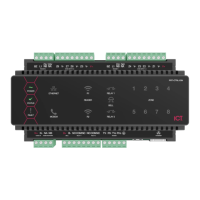⦁ For an area, select the Configuration tab and add a recipient email address to the command window and use
the format: email:yourname@yourdomain.com
⦁ For an input, navigate to the command window for your selected input and use the format:
email:yourname@yourdomain.com
System Settings | Custom Reader Format
This feature is only available in Advanced mode.
A custom reader format can be defined and used if the available preset formats do not meet your needs.
Custom Reader Configuration
⦁ Custom Reader Type: Defines the reader type. The data can either be output as Wiegand (D0 and D1) or
Magnetic Data (Clock and Data).
⦁ Bit Length: The total number of bits that are sent by the card reader for each card badge.
⦁ Site Code Start: The index where the site code data starts in the data transmitted. The count starts at zero.
⦁ Site Code End: The index where the site code data ends in the data transmitted. The count starts at zero.
⦁ Card Number Start: The index where the facility code data starts in the data transmitted. The count starts at
zero.
⦁ Card Number End: The index where the facility code data end in the data transmitted. The count starts at zero.
⦁ Data Format: Defines how the card number that is received from the card reader is handled. If the size of the
site code and card number are less than 16 bits (e.g. Site Start – Site End is less than 16 bits) use 16 bit,
otherwise use 32 bit. If unsure, use 32 bit.
Parity Options (1-4)
There can be up to 4 blocks of parity calculated over the received data.
⦁ Parity Type: The parity type defines the method of calculating the parity for the block. This is either Even or
Odd Parity.
⦁ Parity Location: The parity location defines the location of the parity bit in the received data.
⦁ Parity Start: Defines where the location of the parity block starts in the received data.
⦁ Parity End: Defines where the location of the parity block ends in the received data.
Bit Options (1-4)
⦁ Set Bit: A set bit defines a location in the received data that must always be set (or a logical '1'). The set bit
defines the location of the bit in the received data.
⦁ Clear Bit: A clear bit defines a location in the received data that must always be cleared (or a logical '0'). The
clear bit defines the location of the bit in the received data.
System Settings | Security Enhancement
⦁ Require Dual Credential for Keypad Access: When enabled, a preconfigured numeric credential type labeled
User ID will be automatically added to the Credentials tab of each existing and new user. When adding or
updating a user, the presence of a valid unique User IDwill be enforced. Both the User ID and the user’s PIN will
be required for the user to gain access to a keypad.
⦁ Allow PIN Duplication: When enabled, this option allows more than one user to have the same PIN. This is only
available when the Require Dual Credential for Keypad Access mode has been enabled.
⦁ Default PIN length: Defines the length of PIN that will be generated by the system. If the Default PIN length is
6 and the Minimum PIN length is 4, the system will first generate new PINs 6 digits in length. Once those are
depleted it will generate PINs with 7 digits, then 8 digits, then 5 digits, and finally 4 digits.
⦁ Minimum PIN length: The minimum number of digits (options between 1-8) that will be permitted when
manually entering PINs and when PINs are automatically generated.
Protege WX Integrated System Controller | Configuration Guide 30

